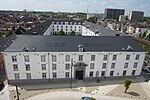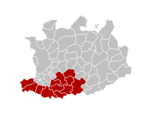Roosendael Abbey

Roosendael Abbey (the abbey of the valley of roses) was a community of Cistercian nuns, founded in the 13th century on the banks of the River Nete in the Duchy of Brabant, at a location now in Sint-Katelijne-Waver. The monastery was established in or before 1227 by the nobleman Gillis Berthout, according to later tradition for his daughters Elizabeth and Oda. An early member of the community who gave it a wider reputation for sanctity was Blessed Ida of Louvain.The monastery was ordered closed in 1795, during the French occupation of Belgium, and the nuns were forced off the premises in January 1797. The main building became a country house in the 19th century.In 1828 the archivist of the National Archives of Belgium was notified that a pile of old parchment was available from a second-hand clothes dealer in Brussels. This transpired to be the remains of the monastery's archives, with over a thousand documents, including papal bulls and ducal charters, the oldest going back to 1235.
Excerpt from the Wikipedia article Roosendael Abbey (License: CC BY-SA 3.0, Authors, Images).Roosendael Abbey
Rozendaal,
Geographical coordinates (GPS) Address Nearby Places Show on map
Geographical coordinates (GPS)
| Latitude | Longitude |
|---|---|
| N 51.071646 ° | E 4.466942 ° |
Address
Rozendaal
Rozendaal
2860 (Sint-Katelijne-Waver)
Antwerp, Belgium
Open on Google Maps






